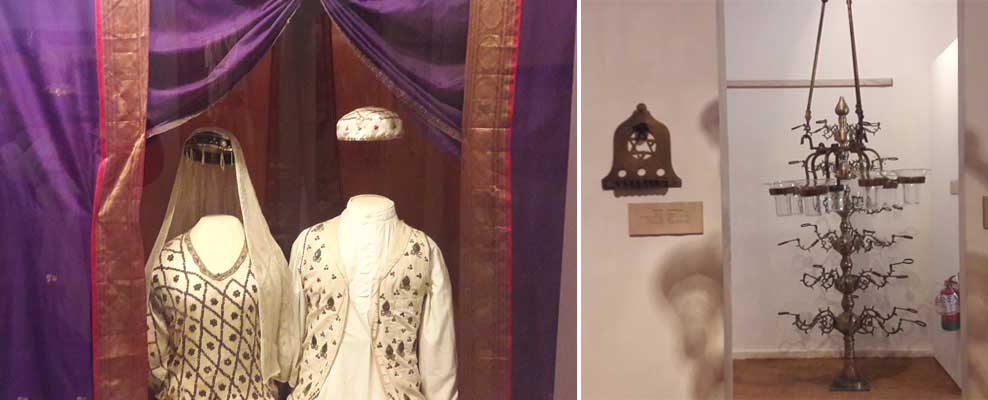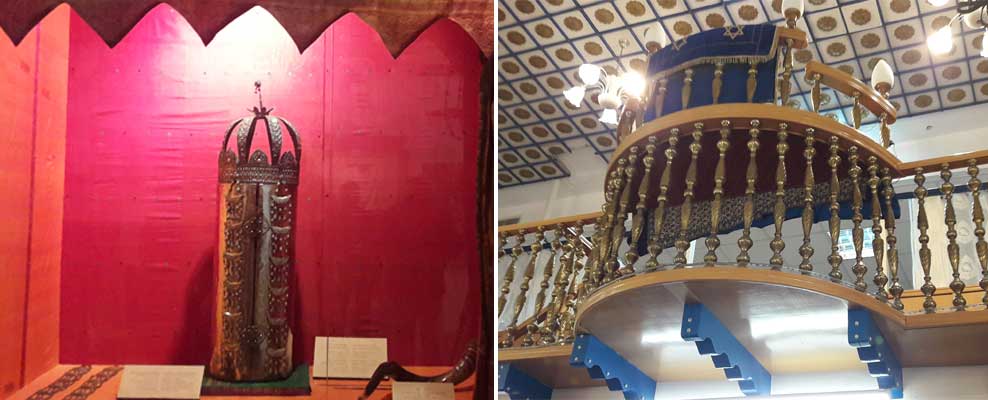There is now a Cochini synagogue and museum in Nevatim, built by the Cochini Jews who emigrated to Israel in the 1950’s after having lived and thrived in India since ancient times. The Malayalam speaking or Malabari Jews of Cochin claim to have fled the Roman invasion and destruction of the Second Temple. The local Maharaja received them when they docked in Shingly in 72 AD and established a Jewish principality for many centuries. In the 15th century they moved to Cranganore where they were under the protection of the Hindu Raja.
The neighborhood in which they lived in Cochin, now popularly known as Jew Town, has the famed Chinese blue and white willow tiled Paradesi synagogue that was built in 1568 by Spanish speaking Jews who sought refuge there. The Paradesi synagogue houses the copper plates given to the Malabari Jews by the Raja granting them certain privileges (10th/11th century AD). Cochini Jews, Malabari and Paradesi (of West Asian and European descent) also lived in the towns of Perur, Chendamangalam, and Matancherry. These Jews were always miniscule in number never numbering more than 2400 in 1947.
The Jewish agency was successful in their efforts to have the majority of Cochini Jews immigrate to Israel between 1953 and 1955. They were settled by the Israeli government in “development towns,” and moshavs that were far from the fertile agricultural lands of Tel Aviv. In these farms each family owns its home and a share of the settlements’s property. Family members look after their assets and the produce is marketed through cooperative institutions. The moshav is managed by an elected council.

Many of the Malabari Jews were settled in moshavs in the Northern Negev, a desert area. Iraqi as well as European Jews from Jugoslavia and Hungary tried to cultivate Nevatim but had not been successful in their endeavors. The Cochinis, who were mostly merchants and peddlers, founded Moshav (collective farm) Nevatim in 1954. With determination and courage they were successful in establishing this agricultural settlement. Through innovative agricultural experiments they developed a highly profitable enterprise in greenhouse flowers that they exported widely to Europe. They also grow citrus fruits, apricots and pears and raise chickens for the Israeli markets. Nevatim is considered one of the more developed of the Negev settlements and families live in two to four bedroom homes.
Besides their hard work and prosperity what is also exceptional about the Nevatim community is that they never forgot their homeland. They built a beautiful synagogue in 1975 and a museum in 1984 that tells of their lives in the villages and towns of Kerala. They sent architects to Kerala to visit their various synagogues to design a traditional Malabari synagogue in Nevatim. Elements from a synagogue in Ernakulam, hachal are integrated in the synagogue design. Ten Torah scrolls also came from Cochin.

The small but splendid two-storeyed red, blue and silver synagogue has a traditional carved wood ceiling that is white and gold in a geometrical design. The Torah ark on the Western wall faces the entrance. It is emblazoned with silver and intricate wood floral carvings painted in red and gold. Torah scrolls are kept in wooden cases decorated with velvet and silver leaf. The central raised platform (bima) is made of polished brass. The many electric lights resemble the oil lamps they left behind. The red walls of the synagogue are decorated with silver ritual items; a large brass menorah stands in one corner. The colors and ritual items make the synagogue look like a studded gem.
Upstairs in the wood decorated balcony is a podium decorated with a deep blue and gold prayer curtain. This balcony on the Eastern end of the sanctuary is used to recite prayers on certain festivals. A woman’s gallery is behind the balcony with a stairway leading up to it. In Kerala the staircase usually ascends from the outside of the building.
Adjacent to the synagogue is the museum where members have painstakingly collected the items brought with them when they came to Israel. On display are the cooking vessels and implements they used, the daily, festive and ritual clothing, ritual items, and many photos of life in Kerala. The customs and traditions associated with Jewish life cycles are explained in both Hebrew and English. For example, a poster describes the dress that men wore for synagogue: young men wore “..long chamisas, wide white pants (kakuppayam) and colorful vests with metal buttons occasionally decorated with gold thread embroidery (satariya). Adults additionally wore “a long, wide, buttonless, silk coat with stiff collar (kappa). The color was dictated by the occasion, as with the women. The men also added a colored hat (topi): respected members of the community wrapped a colored or white scarf (tale chute) around their skullcap.
The other Jewish communities of India in Israel are interested in developing an Indian Heritage Center. They are currently in conversation to expand the museum in Nevatim to include a spiritual complex, a cultural complex as well as an events center. They plan to grow Indian flora and fauna on the grounds. They are reaching out to government and private donors for this endeavor. The synagogue and museum at Nevatim is a wonderful tribute to the culture and heritage of the Malabari Jews.
As Indian Jews, including the Jews of Cochin, are increasingly intermarrying with Jews from other backgrounds, an expanded center to celebrate Indian Jewish heritage is increasingly important for the younger generation to know their heritage. It is also critical that the Indian Jewish experience, the only place in the world where Jews never faced any anti-Semitism, is better known by Israelis.
Photo credits: Jael Silliman
